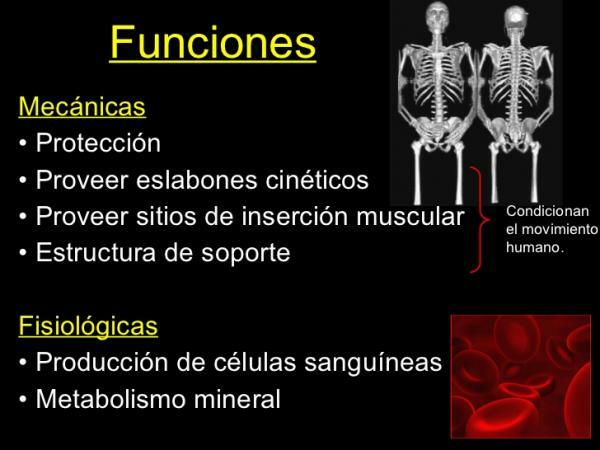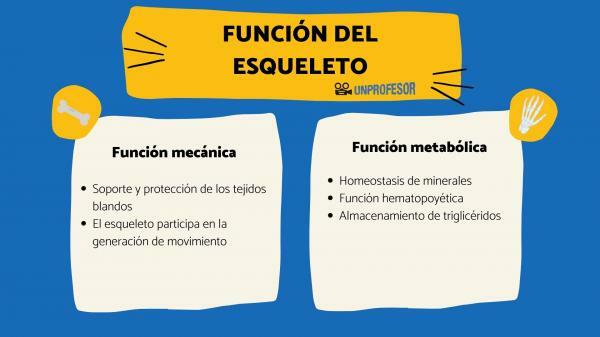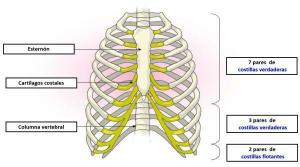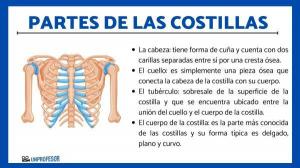SKELETON functions: mechanical and metabolic

The skeleton is an internal structure characteristic of vertebrate animals, in addition to shaping the body of these animals and provide support for soft tissues, performs other less obvious but equally important functions important. In this lesson from a TEACHER we will explain what are the functions of the skeleton both mechanically and metabolically.
As we have already pointed out, the skeleton is capable of carrying out functions of very different kinds. This is possible thanks to bone characteristics, the parts that make up the skeleton.
Bones are made up of two well differentiated types of components: an inert outer part and an innermost zone of living tissue. They are made up of bone tissue and, in some cases, an internal matrix of spongy tissue: bone marrow.
That bone is composed of a mineral structure and living tissue explains why it is capable of carrying out two kinds of functions very different:
- Living tissue is responsible for metabolic functions of the skeleton
- The mineralized external matrix is responsible for the mechanical functions
Within the functions of the skeleton, we highlight the mechanics. Thanks to the presence in the bones of an external matrix of great hardness and resistance, the skeleton has the ability to perform mechanical functions, that is, functions related to the structure and movement of the organism.
Soft tissue support and protection
The hardness and resistance that characterizes bones thanks to its mineralized matrix, is what makes it possible for the skeleton to fulfill two structural functions:
- Support function: The skeleton is a rigid (scaffold-like) structure that supports soft tissues and muscles giving shape to the body and making it possible to maintain the position of the different organs and tissues. The long bones, which are attached to skeletal muscles and vertebrae (irregular bones) that form the spinal column, have a special role in the support function, because they support the weight of the body and allow the maintenance of the posture both in static position and in movement.
- Protection function: The skeleton protects the vital organs of the body, because they form cavities that enclose the organs inside, protecting them from trauma. For example: flat bones of skull protects the brain and those that make up the rib cage protect the lungs and heart. The irregular bones they also have an important role in organ protection. The vertebrae that form the spine protect the spinal cord.
The skeleton participates in the generation of movement
The skeleton is made up of a set of bones that are joined together by means of joints. These joints are in many cases mobile, so that they allow relative displacement between the bones in contact. The presence of mobile joints in the skeleton it allows movement passively, while the muscles are actively responsible for generating these movements through muscle contraction.
- The long bones that make up the limbs and some flat bones (such as those that make up the scapula and pelvis) are attachment points for muscles. In this way, these bones act as the fulcrum (lever) that makes movement possible, because they are displaced from the joint when skeletal muscles contract.
- Others types of bones Like the short bones or the sesamoid bones (which are part of the ends of the tendons) are part of certain joints and therefore also contribute to the performance of certain movements.

Image: Slideshare
We continue talking about the functions of the skeleton talking about the second function: metabolic. The set of biochemical reactions that takes place in living organisms is known by the name of metabolism. The skeleton, in addition to its mechanical functions, participates in metabolism thanks to the activity of cells that are part of bone tissue and bone marrow.
Mineral homeostasis
In the vertebrates the internal environment that bathes the tissues has a stable composition appropriate for cell survival. The maintenance of these conditions of stability in the composition and properties of the internal environment of the organism is the process known as homeostasis. This internal environment, whose conditions remain constant; It is composed of water that contains a series of compounds in solution, among which are phosphorus and calcium in the form of ions.
The mineral matrix of bone contains large amounts of calcium and phosphorus in the form of calcium phosphate and calcium carbonate (salts). Therefore, bones are stores of these two chemical elements. In addition to being part of the bones, phosphorus and calcium, in their ionic form, perform metabolic functions of vital importance in living organisms:
- The calcium it is essential for the proper functioning of cells. The function of Calcium, in its ionic form, is critical in many biochemical processes such as neuromuscular excitability, blood clotting processes, the triggering of enzymatic reactions and the permeability of membranes cell phones.
- The match It is essential for the synthesis of nucleotides such as ATP (a molecule that stores the chemical energy used by cells) and AMP that acts as a chemical messenger and nucleic acids (DNA and RNA) that contain and transmit genetic information.
The ionic forms of Calcium and Phosphorus circulate in the blood. When the levels of phosphorus and calcium decrease in the blood, the bone tissue cells, are capable of mobilizing part of the phosphorus or calcium stored in their mineral matrix to compensate for the deficit of these elements, releasing them into the bloodstream.
Hematopoietic function
This is another function of the skeleton. Hematopoiesis is the process of blood cell formation. These cells have a relatively short life and must be constantly replenished.
The red bone marrow present in some bones is responsible for producing blood cells. Red bone marrow contains mother cells from which the different types of blood cells are produced through processes of cell differentiation.
Triglyceride storage
Triglycerides are lipids (fats) that are stored in the body as a source of energy and are the main components of body fat.
The yellow bone marrow, present in some bones, contains a large amount of adipocytes (fat cells) that are responsible for synthesizing triglycerides and storing them inside in large vesicles.




